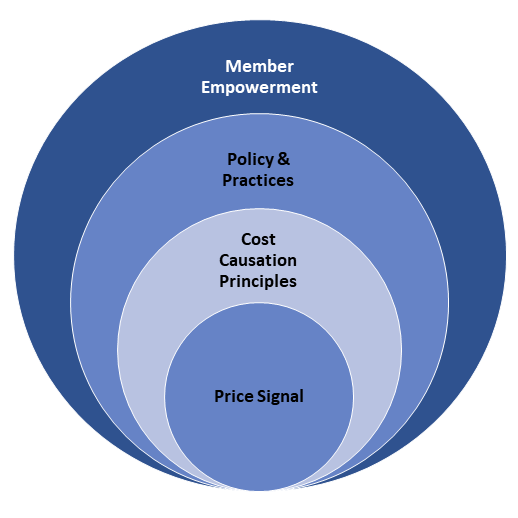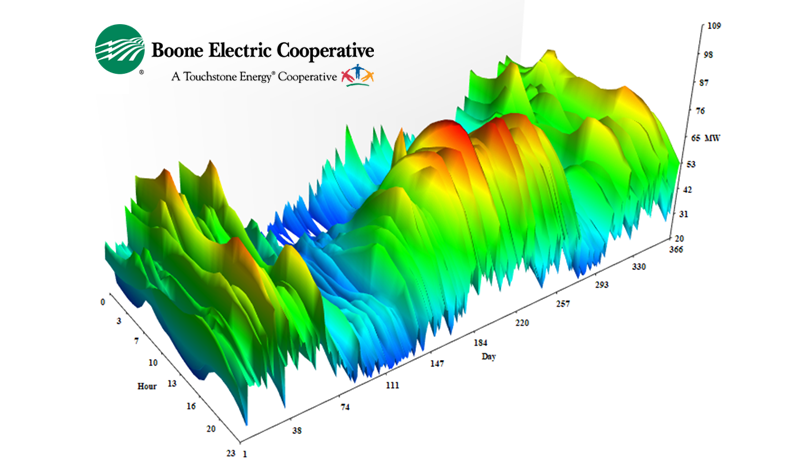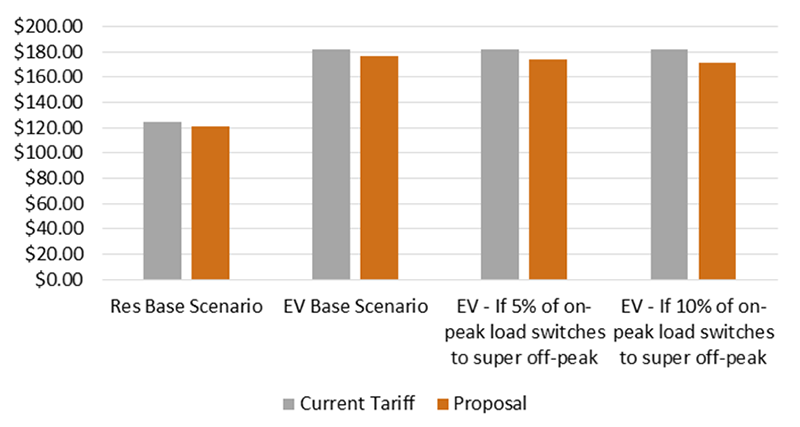CFC Helps Missouri Co-op EVolve With New Rate Option
In June, Boone Electric Cooperative (BEC) introduced a new electric vehicle (EV) rate for residential members designed by CFC. Dubbed “EVolve,” the optional, three-period time-of-use (TOU) rate is expected to be a win-win for the cooperative and its members by offering them opportunities to save on their electricity bill while also reducing costs for BEC through pricing incentives aimed at helping members shift more demand to off-peak periods.
“We expect members to take advantage of the EVolve rate and shift their demand because there is a 4:1 price reduction from the most expensive peak period to the cheapest off-peak period,” BEC Chief Financial Officer and IT Manager Ryan Euliss said. “This shift will save the member money, but it also saves the cooperative money by helping BEC better manage our power cost. The demand component accounts for around 45 percent of our cost of power, and the EVolve rate will help shift usage to times when demand and power costs are lower.”
BEC Manager of Member Services Laura Baker added, “We also wanted to give members more control over how they can benefit from using energy wisely. If their bill is lower, they are happy and they made it happen. We are happy when our members are happy.”
The EVolve rate continues a movement by Columbia, Missouri-based BEC to better align incurred costs with system usage by its more than 32,000 meters.
“From a financial standpoint, our goals continue to be a migration toward rates based on actual cost of service with a sound rate of return,” Euliss said. “We want to minimize the cross-subsidization across rate classes as much as possible. We started this process with our prepaid metering rate and are now continuing it with the EVolve rate. Both of these rates allow the member to manage when and how they use electricity in order to control cost.”

Boone's Objectives
- Meet member requests for rate options
- Encourage technology adoption
- Enable members to be more in control of their electric expenses
- Encourage EV owners to charge when it is most efficient
- Assign costs causing them to be incurred
- Create a win-win situation: reduce costs for both the Cooperative and Members
- Pair rates with G&T EV charger offerings
CFC’s involvement in the rate design project came about when BEC reached out to CFC’s Regulatory Affairs team about potential rate strategies that would support members with EV loads and other members interested in time-varying rates (see “CFC Helps Members Adjust to Changing Climate of Rate Design,” Solutions News Bulletin, October 5, 2020).
CFC had performed a cost-of-service study for BEC in 2019. The data from that study, along with more recent financial and operation reports, were used to help craft the EVolve TOU rate. CFC’s analysis also included 12 months of advanced metering infrastructure (AMI) data and other tariff, billing and energy-related revenue and cost reports.
BEC's 2019 Hourly Residential Load

CFC also conducted load research to understand the energy and power demand patterns of BEC’s members, including those who own EVs. “It is critical in the development of TOU rates to understand the consumption patterns,” CFC Regulatory Affairs Rate and Business Consultant Jefferson Choti explained. “We also undertook an analysis of the production, transmission and distribution costs, which include the costs associated with generating electricity and delivering it to consumers.”
BEC also shared power supply and pricing data from its generation and transmission (G&T) cooperative, Central Electric Power Cooperative, which was critical in enabling CFC to analyze the potential benefits of the EVolve rate for BEC and its members. The power supply data, consisting of the power bills, provided insights, particularly to help determine whether the price signals would be sufficient for members to realize cost savings with time-varying rates.
Time Varying Rates

“Time-varying rates can help distribution cooperatives save money in the long run by reducing capacity costs and other expenses related to peak loads, such as reduced run-time for peaking generation plants,” Choti said. “But in situations where there are no clear price signals from the G&T, the TOU rate may not be as effective.”
In this case, the price signals embedded in BEC’s EVolve rate ensures that adequate compensation is applied to match the cooperative’s cost of power from its G&T.
CFC’s analysis for BEC supported the introduction of a three-period TOU rate with a “super off-peak” period, rather than the more standard two-period structure of “peak” and “off-peak.” The three-period rate maximizes the incentive for members to shift electricity consumption to the cheapest period—allowing them to save more than 75 percent during the super off-peak period vs. the peak period.
Under BEC’s EVolve rate:
- Off-peak pricing (6 a.m. to 5 p.m.) is 7.02 cents/kWh
- Peak pricing (5 p.m. to 9 p.m.) is 18.9 cents/kWh
- Super off-peak pricing (9 p.m. to 6 a.m.) is 4.43 cents/kWh
Unlike some TOU rate tariffs, there is no ceiling on the amount of electricity members can consume during the super off-peak period at the preferential rate. Additionally, any residential member can sign up for the EVolve rate, whether or not they own an EV. BEC members who sign up for the EVolve rate are also eligible for a $250 rebate toward a 240-volt, Level 2 home charger.
To help members evaluate whether the new EVolve rate would work for them, BEC encourages members to use its SmartHub app to monitor their home’s energy use throughout the day. BEC also has an interactive tool on its website to demonstrate how adjusting the time that members use electricity—including charging their EVs—can impact their costs under the new EVolve rate option.
Billing Scenario Comparisons

Although relatively small currently, EV adoption in BEC’s service territory is expected to pick up in coming years and BEC wanted to get ahead of this trend while supporting members’ needs.
“While the EV adoption rate in Missouri is behind the more metropolitan areas of the country, we see our area as ripe for growth,” Euliss said. “Columbia is the home of the University of Missouri and has a population that is more progressive and adept at accepting new technology and environmentally friendly solutions. We see our program as a way to engage with that part of our membership and incentivize EV growth while building a positive relationship with members.”
EV growth is expected to lead to overall electricity demand growth, incentivizing that growth is not the main goal of the EVolve rate.
“We do expect the program to increase load growth, but more importantly it helps us grow load in the less expensive off-peak hours,” Euliss said. “While load growth is important, shifting the charging off the system peak is more important in power cost savings as well as potentially reducing the utility plant necessary to deal with uncontrolled load growth.”
Success for the new rate program will be based on communicating with and educating members about the EVolve rate and stressing the benefits of the optional program. BEC has already put information in its monthly magazine to members, but will continue to use all communication avenues to share this new program, including website, radio, bill inserts, social media and possibly TV.
 BEC members Eric and Joanna Rueter use their EV to run errands for their farm.
BEC members Eric and Joanna Rueter use their EV to run errands for their farm.
“While we don’t believe we are doing anything revolutionary with our EVolve rate program, we feel our approach to engaging membership with an optional program like this is going to be key to its success,” Euliss added. “Members often have a difficult time understanding our industry, and many new and innovative rate programs that are forced onto membership are doomed to fail. We see these optional programs as an important educational tool for members as we try to meet our financial goals around rate design.”
CFC’s approach to designing the EVolve rate involved close consultation with BEC to ensure support of the cooperative’s goals. Past rate-design work underscored that a one-size-fits-all approach does not work well in the electric cooperative network. CFC’s work is grounded in the unique economic fundamentals and characteristics of each of its member cooperatives, as well as the defined and prioritized goals of their boards. Choti explained this approach allows CFC to confidently develop tailored solutions for each of its members.
“CFC continues to be a valuable partner to Boone Electric Cooperative, and we work closely with them on any financial management project,” Euliss added. “Their expertise is invaluable and provides us with the knowledge we need to meet our goals. The EVolve rate was just one more item in a long line of successful projects including our recent cost-of-service study, rate studies and strategic planning sessions.”
For more than 30 years, CFC’s Regulatory Affairs team has worked with member cooperatives on all facets of the rate design process. Today, CFC is helping members develop new rate design approaches to respond to rapidly evolving matters in the energy industry such as EV adoptions, renewable and distributed generation, regulatory policy, climate change policy, and consumer member interests in better managing their electricity usage.
Interested in Learning More About Rate Design?
Contact your RVP to discuss whether CFC's Regulatory Affairs team can help your cooperative.